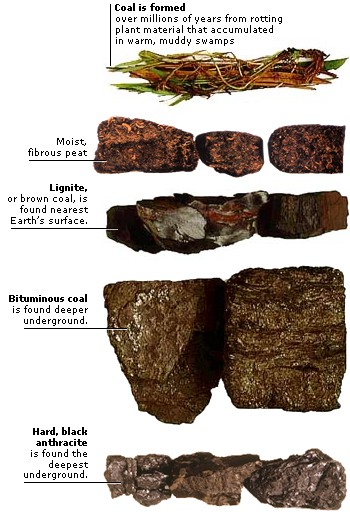DK Earth: Energy Resources
Energy is the force that makes things work. Over many years, people have learned to produce energy from various sources, such as by burning FOSSIL FUELS and using NUCLEAR and RENEWABLE ENERGY technology.
Fuel is something that can be burned to produce energy in the form of heat or power. Fuels include coal, oil, natural gas, and wood. Humans have been burning wood for warmth, and to light homes and cook food, since civilization began. However, in some parts of the world, so many trees have been cut down for fuel that firewood is now scarce.
Fossil fuels are made of the fossilized remains of living things that died millions of years ago. Coal, oil, and gas are the most important fossil fuels. Today, they provide most of the world’s energy.

Plant remains decay to make brown, crumbly peat when they are buried and squashed. Over many thousands of years, more layers build up on top, and heat and pressure convert the remains first to lignite, then to bituminous coal, and finally to anthracite, the highest grade of coal.
Oil is formed from the remains of tiny plants and animals that were buried and squashed on the seabed. Natural gas forms in a way similar to oil and is found trapped in underground reservoirs.
In the 1930s, scientists discovered that huge amounts of energy could be produced by splitting atoms (tiny particles) of a rare mineral called uranium. The technology was first used to make nuclear bombs. Later, it was used to generate electricity.
Nuclear fuel does not release the same polluting gases as fossil fuels, and does not use up the Earth’s natural resources. However, uranium and other nuclear materials are radioactive—they give off radiation that can harm living things. This means that great care must be taken when they are processed and transported. Nuclear fuel is also difficult to dispose of safely once used.
Renewable energy is generated using the power of natural forces such as sunlight. Fossil fuels release harmful waste gases when burned, and they cannot be replaced when their limited supplies are used up. Renewable energy, however, will not run out and produces little pollution.
Most of the energy on Earth comes from the Sun. Solar power uses the energy in sunlight directly. Moving water (in the form of waves, tides, and flowing rivers) and the wind also contain energy that can be used to spin turbines to generate electricity. Geothermal energy taps heat from inside Earth.
Renewable energy will last as long as the Sun shines, winds blow, waves crash, and rivers flow. These technologies are safe to use and do not pollute the environment. However, renewable energy plants can be expensive to build and may not produce enough energy to meet local requirements.



